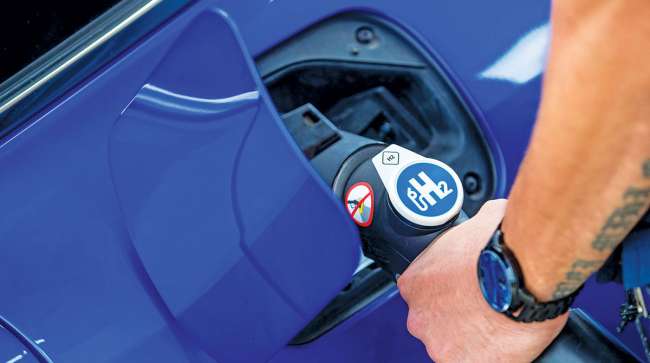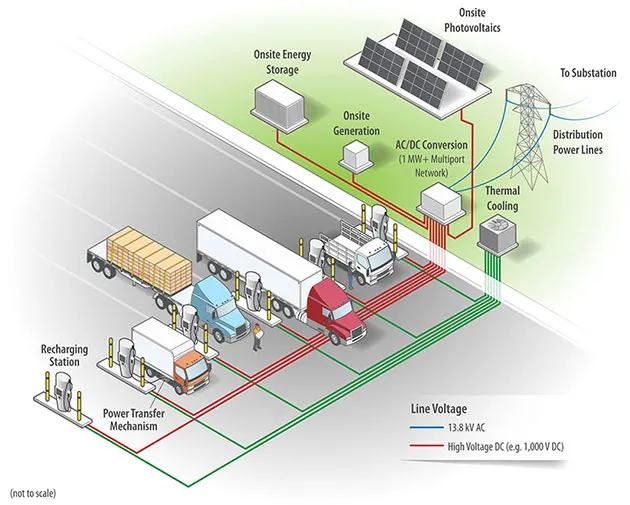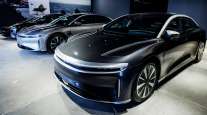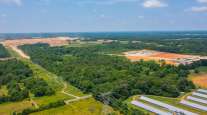Staff Reporter
Freight Routes to Get Electric, Hydrogen Infrastructure Aid

[Stay on top of transportation news: Get TTNews in your inbox.]
A top U.S. Department of Energy national laboratory announced it will help add electric and hydrogen infrastructure to four freight corridors covering over half of the nation.
Golden, Colo.-based National Renewable Energy Laboratory (NREL) officials noted it will collaborate with industry on four federal efforts to create regional infrastructure supporting electric vehicle charging and hydrogen fueling for medium- and heavy-duty trucks along the nation’s most heavily trafficked freight corridors.
The freight corridors are in Utah, the East Coast corridor on Interstate 95 (which spans Savannah, Ga., to Newark, N.J.), the Midwest corridor on I-80 (from Illinois, Indiana and Ohio) and the Northeast/New England corridor.
“The heavy-duty vehicle industry has already developed a wide assortment of zero-emission commercial vehicles. But ubiquitous charging and fueling infrastructure will be key to enabling their widespread adoption,” said Ken Kelly, chief engineer for commercial vehicle electrification at NREL, one of 17 DOE national labs whose mission is to use science and technology to advance federal government initiatives.

NREL is working with other national labs to develop a megawatt-scale charging system for medium- and heavy-duty electric vehicles, enabling drivers to charge in less than 30 minutes at reasonable cost. (NREL)
Kelly revealed NREL will work closely with partners “to leverage vehicle data, innovative analysis tools and zero-emission vehicle infrastructure expertise to help to accelerate infrastructure plans across the U.S.”
The I-95 project is to “establish infrastructure plans for the East Coast as the epicenter of zero-emission freight transformation and improve the quality of life for underserved populations along the corridor,” NREL noted.
It will use its “deep research expertise” with EV electricity grid integration and hydrogen fueling infrastructure computer models to analyze freight flows and needs for energy and infrastructure along the I-95 corridor to identify the best places to locate EV charging and hydrogen refueling stations to support zero-emission commercial vehicle traffic.
NREL researchers will collaborate with a team from the National Grid (a utility providing electricity and natural gas to 20 million customers in Massachusetts and New York) to create a detailed model of truck operations along New England’s freight corridors and use the data to simulate future electric truck operations, ideal charging locations and energy amounts used at those charging stations.
The Northeast project will focus on freight corridors in Maine, Massachusetts, New Hampshire, Vermont, Rhode Island, Connecticut, New York, Pennsylvania and New Jersey to develop a commercial EV charging blueprint as a prototype for other regions.
Researchers will use proprietary NREL software tools and computer modeling to craft a plan for the most cost-effective deployment of large-scale EV charging. That data will be given to National Grid as the company plans to expand its grid infrastructure to meet future service requests.
Other Northeast project partners are the New York State Energy Research and Development Authority, Northeast States for Coordinated Air Use Management, the Port Authority of New York and New Jersey, Applegreen Electric (which designs and operates EV fast-charging facilities) and Calstart, a Pasadena, Calif.-based nonprofit promoting zero-emission transportation that is involved in all four of NREL’s freight corridor projects.
Want more news? Listen to today's daily briefing above or go here for more info
The I-80 Midwest corridor project involves a Cummins Inc. team working with NREL researchers to develop extensive plans for battery-electric charging and hydrogen fueling stations through Illinois, Indiana and Ohio. The objective is to transition 30% of the region’s medium- and heavy-duty fleets to zero-emission technologies by 2035. Project partners include Indiana Motor Truck Association, Purdue University, the Indiana Department of Transportation (INDOT), Chicago Metropolitan Agency for Planning, Northern Indiana Public Service Co. and Pilot Travel Centers.
NREL’s Utah project centers on underserved people in the greater Salt Lake City region along the Wasatch Mountain Range, home to 80% of the state’s population. NREL will provide operational data on commercial vehicles’ duty cycles plus input on EV charging, electrical grid interconnections and hydrogen infrastructure requirements.
This effort also involves IMTA, Pilot Travel Centers and INDOT as well Argonne National Laboratory, Greater Indiana Clean Cities and Northern Indiana Public Service Co. and others. The objective of this project is to develop a community-, state- and industry-supported action plan to electrify the freight corridor along the state’s Wasatch Front.




